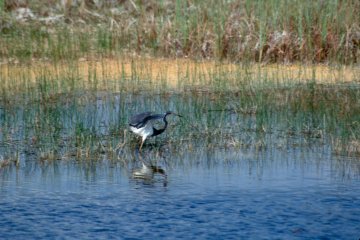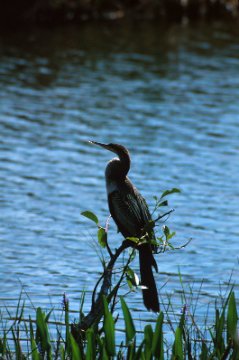Florida
2000
Monday, May 1st
What a relief to
finally take the other shoe off.
If you ever want
me to plan a birding trip for you, today's report may make
you change your mind. I had planned to get up at 4:30 (did go to sleep early
last night) but for some reason the alarm did not go off (did
I turn it off or set it wrong) so I didn't get up until about 5:15 AM. I checked
out of the hotel and started on my way at 6:00 AM. There was a very light
drizzle as I left but it soon stopped.
I saw my first
Wood Stork of the trip on the side of I-95 in North Miami
Beach. I drove along the Tamiami Trail (that
is the name of the highway)
towards the Shark Valley Area of Everglades National Park. The highway is
a two-lane road with a fairly high speed limit that seems to
be commonly exceeded. (The state advises that you have your headlights on so you
can tell whether the car in your lane is traveling in your direction or one that
is passing another and coming at you at high speed). Bearing that in mind, I had
trouble keeping my eye on the road because I was looking for birds in the trees
and canals. Saw a number of the "common" birds - egrets, herons,
Anhinga, etc. Did get a good look at an Osprey and a quick view of a
Red-shouldered Hawk. There were an incredible number of Black Vultures in the
trees, on poles, and on the ground. Surprisingly, I did not see one Turkey
Vulture while driving until I entered the Big Cypress Preserve area. You may ask
why was I at the Big Preserve area of the road when it is past the entrance to
Shark Valley. Simple. The park doesn't open until 8:30 and I arrived at 8:00.
(Good thing that I hadn't gotten up at 4:30 as I intended.) I drove on to kill a
little time. (The Snail Kites were not present at the Miccosukee Restaurant).
The Shark Valley
area is on the northern section of the park. The original
Everglades extended much further north, but a lot of it has been developed.
(Loxahatchee is part of the Everglades, but not the park). I had been to Shark
Valley in February 1982 and March 1984 and had tried to go in the 1990s but that
section of the park was closed because of severe flooding caused by a hurricane.
The water levels at those
times of the year were higher than today. In fact, there were many dry areas
that had been under water in the earlier months of the year. The birds usually
raise their young in the drier seasons as the food sources are concentrated in
the remaining pools (many of which are created by alligators). Anyhow, I had
another hour to kill as the first tram did not leave until 9:30. Private
vehicular access to the park is restricted to prevent overcrowding. Therefore,
one can only go in on foot, bicycle or on the tram.
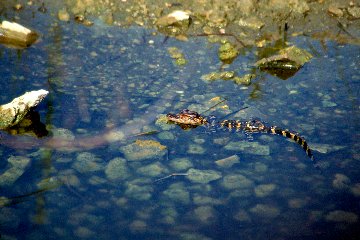 Watched an
alligator and some large schools of fish in the waters by
the
visitor center. Most of them just stayed in one place, but some would
occasionally jump and splash. I believe most were gar. A large number of Green
Herons flew overhead. The tram was filled with several classes of students, but
I managed to get a whole row to myself (so I could slide from side to side to
take pictures). The driver/guide pointed out the wildlife as we went along and
gave some information the animals and about the park itself. We saw a baby
alligator that was less than a foot long - it had stripes and was less than a
year old. Alligators may grow a foot a year and keep their stripes for several
years. After the age of five, the growth varies so age cannot be determined by
size. I believe the guide said that the record Florida alligator was about 17
feet long.
Watched an
alligator and some large schools of fish in the waters by
the
visitor center. Most of them just stayed in one place, but some would
occasionally jump and splash. I believe most were gar. A large number of Green
Herons flew overhead. The tram was filled with several classes of students, but
I managed to get a whole row to myself (so I could slide from side to side to
take pictures). The driver/guide pointed out the wildlife as we went along and
gave some information the animals and about the park itself. We saw a baby
alligator that was less than a foot long - it had stripes and was less than a
year old. Alligators may grow a foot a year and keep their stripes for several
years. After the age of five, the growth varies so age cannot be determined by
size. I believe the guide said that the record Florida alligator was about 17
feet long.
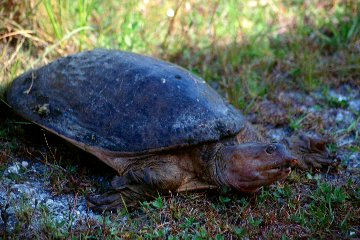 |
We came upon three
River Otters on the road. The guide said she had never
seen any on the road before. We also looked at Soft-shelled Turtles and Red
Sliders. Green Herons continued to be abundant, but White Ibis were the number
one species seen. I picked up a Pied-billed Grebe (which no one else saw) as a
trip species. I called out to the guide that I saw a rail and she said something
about a female Boat-tailed Grackle. I don't know if she was looking at something
else, but I am positive it was a Sora. Added American Crow to the trip list also
- not a very exiting find, but all the others I had seen so far were Fish Crows. |
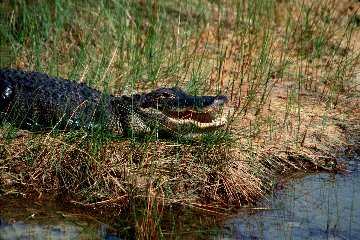 I won't mention
all the herons and egrets I saw since they were the usual ones. However, this
was the first time that I had seen adolescent Little Blue Herons in flight. The
patterns of white and blue were quite attractive but could be extremely
confusing. Saw my first confusing sandpipers of this trip - yellowlegs. I
identified them as Greaters by bill size and calls. Enjoyed watching Wood Storks
in flight. Very attractive
and graceful in the air (if one ignores their faces). While the guide was
showing a King Rail to the group (a species I have seen only once before),
"I" found a Limpkin on the other side. We would come upon a few more
in a little while. We saw several families of Common Moorhens - the views were
not as good as I had yesterday.
I won't mention
all the herons and egrets I saw since they were the usual ones. However, this
was the first time that I had seen adolescent Little Blue Herons in flight. The
patterns of white and blue were quite attractive but could be extremely
confusing. Saw my first confusing sandpipers of this trip - yellowlegs. I
identified them as Greaters by bill size and calls. Enjoyed watching Wood Storks
in flight. Very attractive
and graceful in the air (if one ignores their faces). While the guide was
showing a King Rail to the group (a species I have seen only once before),
"I" found a Limpkin on the other side. We would come upon a few more
in a little while. We saw several families of Common Moorhens - the views were
not as good as I had yesterday.
The tram stopped
to look at several alligators. One pool had two large specimens. The guide said
it was very unusual to see two adults together except in mating season. By the
way, the female will stay by the nest while the eggs are incubating and then
with the young after they hatch. She is very protective of her brood. (Males may
eat the young.) We came upon an alligator that was missing part of its tail and
its left front leg. The guide said this gator had survived in this condition for
years.
More birds -
Several Black-necked Stilts were probing in the mud.
Really
elegant birds. Then a large mixed flock of white birds took off. Mostly White
Ibis, a good number of Snowy Egrets mixed in. The guide said there was a Roseate
Spoonbill in with them. I don't know how I couldn't find a pink bird amongst the
white, but I couldn't. I was very disappointed. A little later, we came upon
another flock which also took off. The spoonbill in this flock must have been
brighter, so I was able to find it. Got a good look at it in the air and an even
better one once it landed. Great views of its odd bill. The final bird on the
tram ride was a Black-crowned Night-Heron. As the tram approached the viewing
tower, the guide announced that for the first time birds were using the area
around the tower as a rookery
The First Florida Page
At the Observation Tower
 Go to the SongStar home page
Go to the SongStar home page
Drop me a note
Copyright © 2000 Richard L. Becker
 Watched an
alligator and some large schools of fish in the waters by
the
visitor center. Most of them just stayed in one place, but some would
occasionally jump and splash. I believe most were gar. A large number of Green
Herons flew overhead. The tram was filled with several classes of students, but
I managed to get a whole row to myself (so I could slide from side to side to
take pictures). The driver/guide pointed out the wildlife as we went along and
gave some information the animals and about the park itself. We saw a baby
alligator that was less than a foot long - it had stripes and was less than a
year old. Alligators may grow a foot a year and keep their stripes for several
years. After the age of five, the growth varies so age cannot be determined by
size. I believe the guide said that the record Florida alligator was about 17
feet long.
Watched an
alligator and some large schools of fish in the waters by
the
visitor center. Most of them just stayed in one place, but some would
occasionally jump and splash. I believe most were gar. A large number of Green
Herons flew overhead. The tram was filled with several classes of students, but
I managed to get a whole row to myself (so I could slide from side to side to
take pictures). The driver/guide pointed out the wildlife as we went along and
gave some information the animals and about the park itself. We saw a baby
alligator that was less than a foot long - it had stripes and was less than a
year old. Alligators may grow a foot a year and keep their stripes for several
years. After the age of five, the growth varies so age cannot be determined by
size. I believe the guide said that the record Florida alligator was about 17
feet long.

